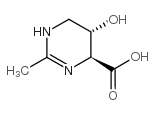HYDROXYECTOINE

HYDROXYECTOINE structure
|
Common Name | HYDROXYECTOINE | ||
|---|---|---|---|---|
| CAS Number | 165542-15-4 | Molecular Weight | 158.15500 | |
| Density | 1.56g/cm3 | Boiling Point | 465.2ºC at 760 mmHg | |
| Molecular Formula | C6H10N2O3 | Melting Point | N/A | |
| MSDS | Chinese USA | Flash Point | 235.2ºC | |
| Symbol |

GHS07 |
Signal Word | Warning | |
|
Metabolites associated with adaptation of microorganisms to an acidophilic, metal-rich environment identified by stable-isotope-enabled metabolomics.
MBio 4 , e00484-12, (2013) Microorganisms grow under a remarkable range of extreme conditions. Environmental transcriptomic and proteomic studies have highlighted metabolic pathways active in extremophilic communities. However, metabolites directly linked to their physiology are less w... |
|
|
Synthesis of 5-hydroxyectoine from ectoine: crystal structure of the non-heme iron(II) and 2-oxoglutarate-dependent dioxygenase EctD.
PLoS ONE 5 , e10647, (2010) As a response to high osmolality, many microorganisms synthesize various types of compatible solutes. These organic osmolytes aid in offsetting the detrimental effects of low water activity on cell physiology. One of these compatible solutes is ectoine. A sub... |
|
|
Evaluation of 3-hydroxybutyrate as an enzyme-protective agent against heating and oxidative damage and its potential role in stress response of poly(3-hydroxybutyrate) accumulating cells.
Appl. Microbiol. Biotechnol. 100 , 1365-76, (2016) Poly(3-hydroxybutyrate) (PHB) is a common carbon- and energy-storage compound simultaneously produced and degraded into its monomer 3-hydroxybutyrate (3HB) by numerous bacteria and Archae in a metabolic pathway called the PHB cycle. We investigated 3HB as a c... |
|
|
K. Lippert, E.A. Galinski
Appl. Microbiol. Biotechnol. 37 , 61, (1992)
|
|
|
T. Sauer et al.
GIT Labor-Fachzeit. 39 , 892, 894, (1995)
|
|
|
M.D. Vangala et al.
Bioforum 23 , 760, (2000)
|